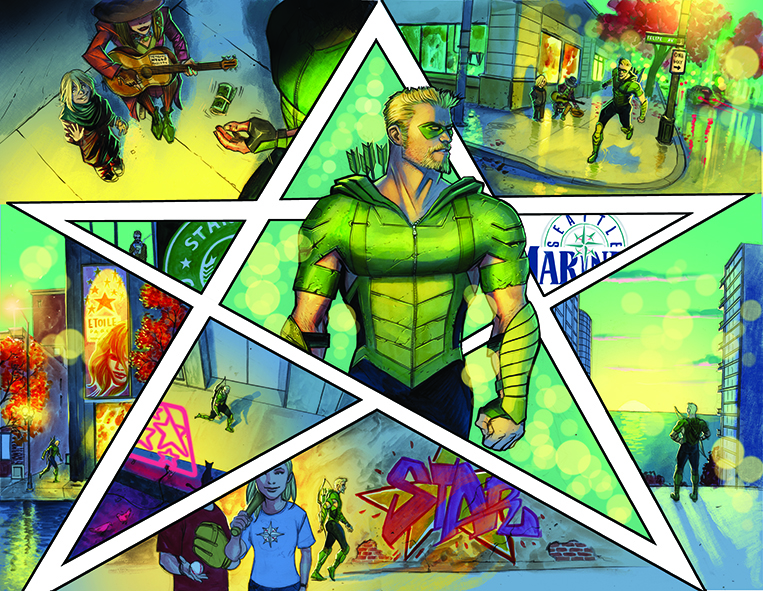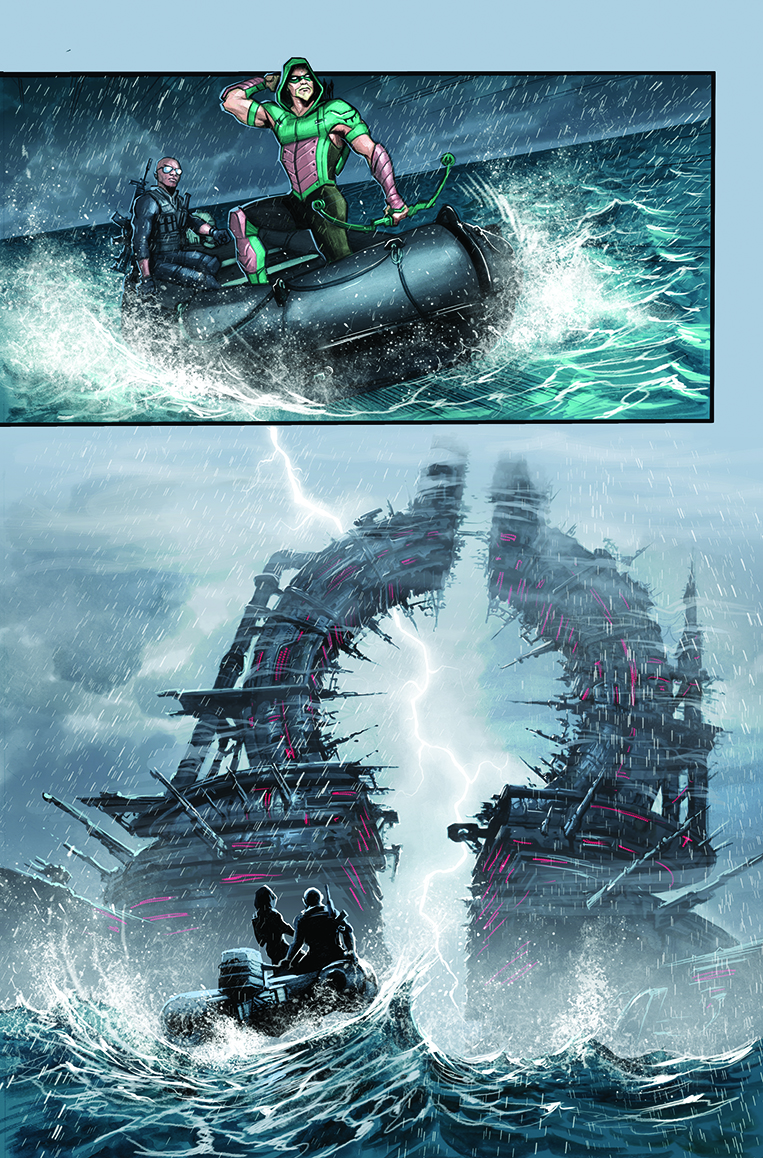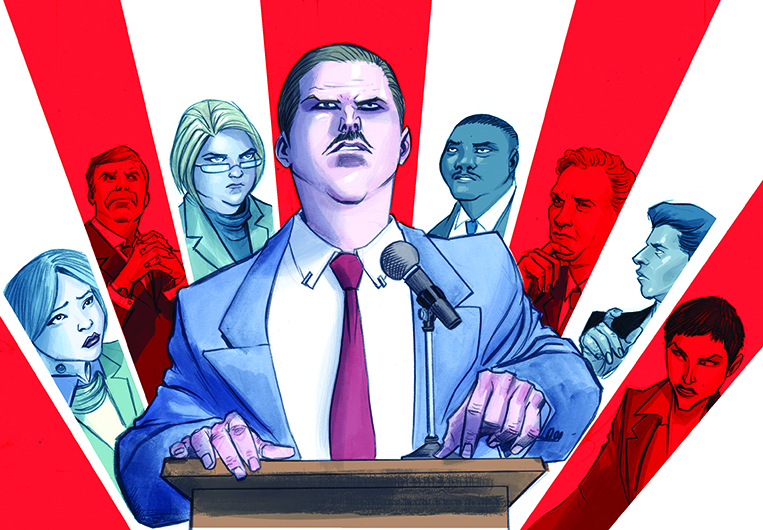We live in a time of fear and uncertainty. We can’t trust the people we’re supposed to trust. Politicians are caught up in lies, movie producers and church leaders turn out to be sexual predators, athletes juice, musicians steal. Wildfires rage. Police and protestors clash. And a villain moves among us, one that unfortunately doesn’t wear a black cloak or a hockey mask or have spiked tentacles or cloven feet, but travels invisibly in the air we breathe.
So there is something particularly reassuring about the moral mathematics of cape-and-spandex comics. The equations often work out. Justice prevails. Maybe it will strike some as corny or ridiculous, but as someone who didn’t grow up in a particularly religious family, Captain America had a greater impact on my sense of integrity and charity than Jesus ever did.
I’ve been thinking about this a lot lately—especially with the constant clash of heroic and villainous forces in the headlines. How reassuring it would be to believe in a pure, simplistic formula of good and evil. But things are more complicated than that. I don’t believe in the absolute purity and big-heartedness of Superman, just as I don’t believe in the absolute chaos and villainy of the Joker.
But there is something essential to be learned—about characterization, the fundamental core of storytelling—from comics. If your narrative doesn’t have a beating heart at the center of it, nobody is going to care how mind-melting your time-loop theory, how scary your vampire train, or how awe-inspiring your ninja fight choreography.
And the way in which your heroes and villains compliment and feed off each other is the emotional bedrock of what will become your theme and narrative. So let’s talk about character in superhero comics.
Key insight is a term thrown around often among screenwriters. The character has one thing—above all else—that controls and motivates them. A secret. A death. I prefer the term core wound, because this key insight so often relates to trauma. Especially in comics.
Soon after telling Peter Parker that with great power comes great responsibility, Uncle Ben surprises a burglar and ends up shot dead. The Wayne family leaves the theater and walks through (the aptly named) Crime Alley, where Martha and Thomas Wayne are mugged and pearls and blood splash the ground as little Bruce watches. Frank Castle’s wife and kids are killed by the mob, Clark Kent’s home planet of Krypton is blown to smithereens, N’Jadaka’s father is murdered. I could go on. But here you have the core wounds of Spider-Man, Batman, the Punisher, Superman, and Killmonger.
The core wound of a character typically precedes the story itself or is featured early in the first act. Freddy Kruger kills the teenagers in A Nightmare on Elm Street because their parents long ago burned him to death for molesting children, something that happened long before the present-day narrative unfolds. Sleepless in Seattle opens with a shot of Tom Hanks standing over his wife’s grave. Liam Neeson’s daughter is kidnapped in the first twenty minutes of Taken, as is Mel Gibson’s son in Ransom.
In Kazuo Ishiguro’s The Remains of the Day, Mr. Stevens is a butler who prizes honor and dignity and hard work above all else. He has devoted his life to the service of a man who turns out to be a Nazi sympathizer. This knowledge is crippling, his core wound. It motivates Mr. Stevens’s defensive and heavily edited recollection of his career as he finally comes to terms with his mistakes and questions what to do with the remains of the day, the last chapter of his life.
Yes, people are complicated and three-dimensional and suffer from competing desires. But in the service of story, I can’t tell you how helpful it’s been to home in on a single thing, the bloodiest wound. Out of this rises the motivation that drives the narrative. Look to Cheryl Strayed’s Wild and you’ll find the author grieving her mother and compelled to hike the Pacific Crest Trail to escape her crippling sadness and rediscover herself. Look at Colson Whitehead’s The Nickel Boys (racial persecution), Hanya Yanagihara’s A Little Life (sexual abuse), Victor LaValle’s The Changeling (a missing father). I’m talking about superhero comics, but I’m not talking about superhero comics.
Sometimes there is a direct connection between the core wound and the villain of your story (as in The Punisher or Taken or Death Wish). And sometimes there is an indirect connection. Consider Jaws—not the superior film, but the rather clumsy novel by Peter Benchley. In it Hooper, the marine biologist, sleeps with Chief Brody’s wife. So our protagonist is cuckolded. Shamed at work and shamed at home, he sets off for the sea to reclaim his masculinity by killing a giant scary penis (I mean, shark).
The hero might better their villain, and yet they’ll never be as great as their villain. The villain is forever more interesting. The villain is the reason we read the novel or watch the film. Think of everyone from Jason Voorhees to the judge in Cormac McCarthy’s Blood Meridian to Spanish influenza in Lauren Groff’s “L. Debard and Alliete” (from her excellent 2009 collection Delicate Edible Birds) to the Misfit in Flannery O’Connor’s “A Good Man Is Hard to Find.” Yes, it is because these villains are eccentric and frightening and colorful, a keg-powder of drama, a shot of mercury to the narrative jugular. And yes, it is because they’re often the reason the story is being told at all, since they create the trouble that must be resolved.
But it is also—centrally—because the villain represents the internal struggles and emotional development of your hero. The villain doesn’t just drive the plot, in other words; the villain allows the hero to triumph over their inner weakness, to balm their core wound. The heart of your story perversely comes to life through the villain.
Maybe nowhere is this more obviously illustrated than in the rogues gallery of Batman, which is the best of the best in comics. Every Scarecrow story should be about Batman learning to master his fears—and then employing those same fears as a weapon. Every Two-Face story should represent duality, the constant struggle for identity and emotional control, and the answer to the ultimate question: Is Bruce Wayne the real man, and Batman the costume, or is Batman the real man and Bruce Wayne the costume?
Mr. Freeze represents Bruce’s emotional coldness. Killer Croc represents the savagery within.
The Joker is the very opposite of Batman—the reason he exists at all. The Dark Knight wants to bring checks and balances to the broken judicial system, law and order to the mean streets of Gotham, and the Joker epitomizes the chaos he fights. Poison Ivy, on the other hand, is more of a dark mirror, who—like Bruce—is trying to avenge her parents, trying to bring back natural order and life to a planet humans keep destroying.
This isn’t a hard-and-fast rule, but in general, the very best villains are either the opposite or a dark mirror of the hero. Zod is a dark mirror to Superman, whereas Bizzaro is his opposite. Aries is a dark mirror to Wonder Woman, whereas Cheetah is her opposite. Venom is a dark mirror to Spider-Man, whereas Vulture is his opposite.
Sherlock Holmes finds a dark mirror in Moriarty, someone who matches his intelligence but uses it for evil. Indiana Jones finds a dark mirror in Belloq, someone who matches him as an archaeological scholar, but uses this knowledge for profit and power.
![]()
Let me show you how these theories actually come into play in my work. I wasn’t simply hired to write Green Arrow, my first ongoing comics series. I was part of a bake-off. This means that several writers were encouraged to submit pitches, but only one would make the cut. At the time, I had published two novels and two books of short stories, yes, but only two issues of Batman. So I was a comics rookie and knew I had a lot to prove. So I did what I always do and went overboard. Instead of a pitch, I wrote a bible. Thirty single-spaced pages that walked the editors through my understanding of the character and what I hoped to do with him. I was already familiar with Green Arrow, but I did a deep dive into the archives and reread everything I could get my paws on. I wanted to take the character in my own direction but I also wanted to tip my hat to legacy.
From Green Arrow #24, in which Seattle is reborn as Star City, becoming the first privately controlled metropolis in America. Artwork by Juan Ferreyra.I got the gig—and I wrote thirteen issues before DC Comics decided to relaunch their entire line, all titles appearing under the banner of Rebirth. I flew out to LA for a few days of meetings at the mothership. The entryway of the DC Comics headquarters features a Batmobile racing game, racks of new comics, and costumes from the films arranged in glass pillars. A hive of cubicles runs down the center of the office space, all of them decorated with posters and Pop figures and statues of superheroes in battle poses. I walked into an office with a white board covering one wall and windows looking out on sunny Burbank. This is where Geoff Johns—the industry heavyweight and chief creative officer of DC at the time—met me. We didn’t leave the room all day, ordering in pizza, pacing the floor, scratching notes on the white board, calling in different people to consult on plot points. It was an incredible learning experience, one that would inform how I, in the years to come, would approach writing bibles and outlines for everything from comics to novels to podcasts to television series.
We started with lists. An archive of the canon. Villains. Sidekicks. Love interests. Most famous storylines. Weakest storylines. Best and worst costumes. Best and worst examples of his weapons and powers. Core emotional characteristics. That kind of thing. Once we figured out Oliver Queen’s history, we could chart out his future.
My pitch argued that the character had lost touch with his legacy. He was originally conceived as a Robin Hood character. A character who battled against the rich and on behalf of the poor and underrepresented. He was—in the early years of Dennis O’Neill and Neal Adams—a liberal loudmouth, always shaking his fist at the fat cats and fascists of the world. So I proposed to strip Oliver Queen of his wealth—and the protection of his family business—and cast him into the woods outside Seattle. This key insight—or core wound—gave rise to the two central villains of my run.
If you’re writing something bigger—a novel, a memoir, a season of television, a fifty-two-issue run on a comics series—you want both a dark mirror and an opposite present to fully explore your character’s weaknesses. That’s what I did for Green Arrow, joined by artists Juan Ferreyra and Otto Schmidt.
From Green Arrow #4, featuring the Inferno, a bank designed to finance the evil plans of global super-villains. Artwork by Juan Ferreyra.I proposed to Geoff Johns that day in the DC offices that a bank be Oliver Queen’s nemesis. “A bank?” he asked, wrinkling up his forehead. “That sounds pretty boring at first glance, but keep going.” I argued that being a super villain must be expensive. How are these guys funding their secret lairs and elaborate costumes and weapons? You can’t just go into a Wells Fargo and apply for an evil incentive loan. So what if there was a black bank—a night vault—available to them? It would be offshore—in international waters—a mobile unit. This is what we ended up calling the Inferno, a battleship influenced by neo-gothic designs of The Matrix and Dark City. This entity was known as the Ninth Circle, and their hellish cabal would be working behind the scenes constantly to influence and profit off of business, military, and political affairs. My villain, in other words, was the one percent. The very opposite of Oliver Queen, who was doing his best to fight inequity in part because of his guilt over his privileged past.
From Green Arrow #24, featuring Nate Domini, the mayor-villain of Seattle. Artwork by Juan Ferreyra.Then we brainstormed a dark mirror, an adversary who had much in common with our hero. This was Nate Domini, the mayor of Seattle and a former classmate of Oliver’s during their prep school days. He too was born into a wealthy, connected family, but his politics couldn’t be different. If Green Arrow was Robin of Loxley, then Nate Domini was Prince John. They are on parallel but divergent paths, and we can see in Domini what Queen might have become, if not for the trauma that befell him. And of course Domini will tempt and bribe and blackmail and threaten Queen, trying to draw him back in.
Everything I’m talking about here happened before I scripted. If you’re working with characters worth billions of dollars, you don’t have a choice: you need to prove you’ve got a substantive roadmap before the corporate overlords hand you the keys. The same process applies to TV, film, and audio drama. And though I might have once found this kind of projective thinking to be artificial and annoying—a left-brain imposition on a right brain activity—it has proven so valuable that I now take the same preparatory approach with everything I write, no matter the medium.
Figure out who your main character is. Figure out what their core wound is, what their central weaknesses are, and the villain will spring from there. Their interaction will give rise to your thrilling plot, and your thrilling plot will then ultimately deliver an emotional transformation (as the hero overcomes not just the villain, but their own insecurities and fears and injuries) that makes the story ultimately meaningful.
Benjamin Percy writes Wolverine and X-Force for Marvel Comics. He is also the author of five novels, three story collections, and a book of essays, Thrill Me (Graywolf Press, 2016), that is widely taught in creative writing classrooms.










